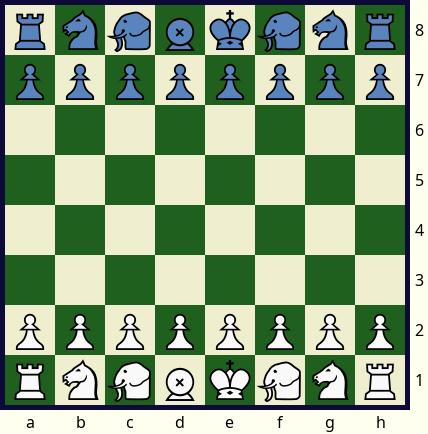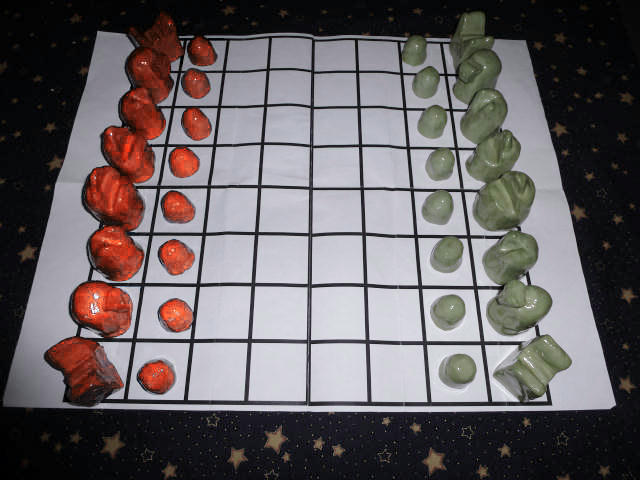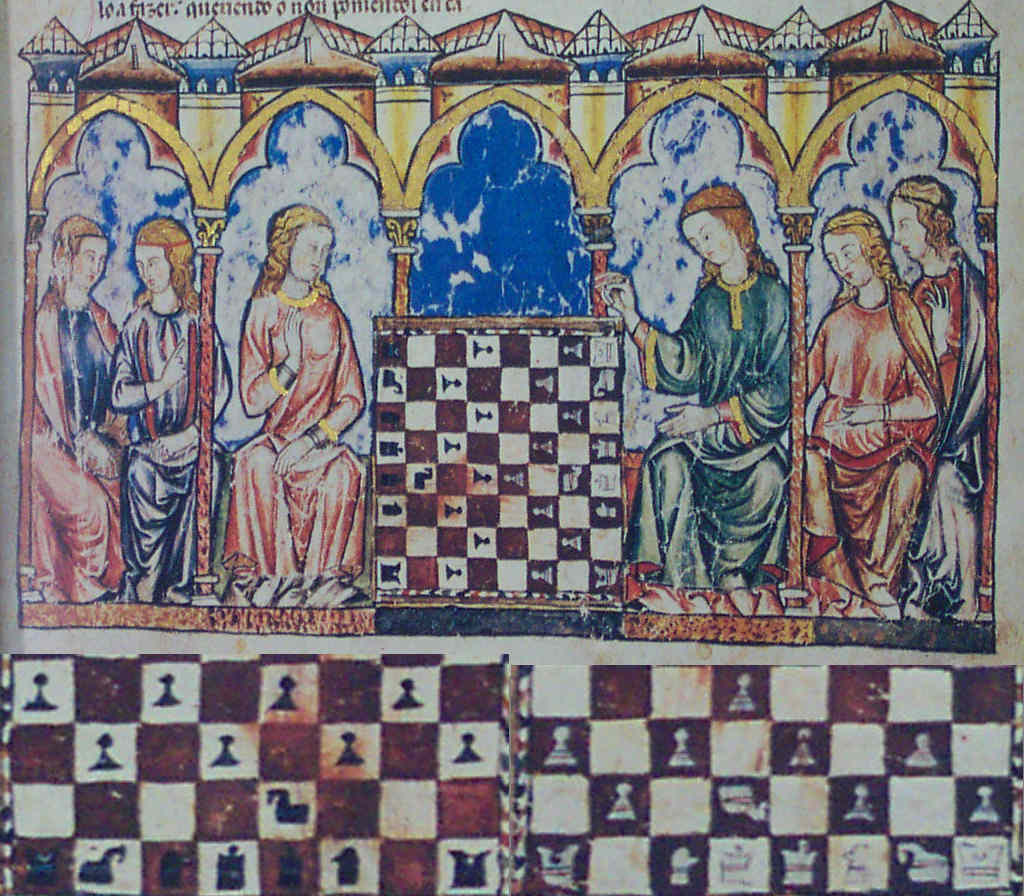Shatranj
Shatranj is the Arabian form of Chess. Its name is just an adaptation of the Persian name Chatrang to Arabic. Some time after the death of Mohammed, the Arabs conquered Persia and learned about Chatrang, which was the Persian form of the Indian game Chaturanga. Its name too was a modification of the earlier name, which was Sanskrit for the four arms of the military.
Because records of Chaturanga and Chatrang are sparse, the exact rules for these games are unknown, and it's generally presumed that they were more or less like Shatranj. Unlike its predecessors, Shatranj stands out for being well-documented, making it the earliest Chess variant we have detailed rules for. This game had professional players and a body of literature, and it is the main predecessor of the game we normally know as Chess. Since Shatranj first came to Europe by way of the Iberian peninsula, it's noteworthy that the Spanish and Portueguese names for Chess, ajedrez in Spanish and xadrez in Portueguese, are modifications of the name Shatranj.
Setup
The array is similar to that of Orthodox Chess, but it had Elephants instead of Bishops and Generals instead of Queens. It was originally played on an uncheckered board, but in 13th century Spain during the reign of King Alfonso X, it was being played on a checkered board.

Black:
King d8; General e8; Rook a8, h8; Knight b8, g8; Elephant c8, f8; Pawns
a7, b7, c7, d7, e7, f7, g7, h7.
White:
King d1; General e1; Rook a1, h1; Knight b1, g1; Elephant c1, f1; Pawns
a2, b2, c2, d2, e2, f2, g2, h2.
The game was also played with Generals and Kings transposed. Besides the position illustrated above, the Kings could start on d1 and d8, and the Generals could start on e1 and e8. Mathematically, this made no difference, because both Kings always started in one central file and both Generals in the other.
Pieces
Shāh or King | Moves one space in any direction but not into check. It moves just as it does in Chess except that there is no castling. |
Rukh or Rook | Moves across any number of spaces in the same rank or file but no further than the first occupied space, just as it does in Chess. Unlike the Chess Rook, it may never castle with the King. |
Faras or Knight | Leaps in an L-shaped 1-2 or 2-1 pattern, just as it does in Chess. |
Firzān or General | Moves to any diagonally adjacent space. |
Fil or Elephant | Leaps two spaces diagonally. It may leap over an intervening piece, just as the Knight can, but it must move precisely two spaces in the same direction, and it cannot stop on the first space. |
Baidaq or Pawn | Moves one space straight forward without capturing or one space diagonally to capture. Unlike the Chess Pawn, it may not make a double move, it may not capture by en passant, and all it may promote to upon reaching the last rank is a General. |
Rules
Shatranj is the main forerunner of modern Chess, and it was played a lot like it. In addition to the piece differences noted above, its rules differed from Chess in the following respects:
- Stalemate counts as a win.
- Bare King counts as a win, provided that your King cannot be bared on the very next move. In the event that you could bare your opponent's King on the next move, the game is drawn.
For the most part, the preceding rules are agreed upon by King Alfonso X, H. J. R. Murray, John Gollon, Harry Golombeck, David Pritchard, and Wayne Schmittberger. Here are some variations on the rules not agreed upon by all sources:
- In The Encyclopedia of Chess Variants , Pritchard cites a the rule that a stalemated King may be transposed with one of the same player's other pieces, as long as this does not result in check.
- In New Rules for Classic Games, Schmittberger adds that
Perpetual check and repetition of moves are also draws.
(p. 188) - In A Short History of Chess, Murray mentions a rule local to Medina that baring the King immediately wins the game even if it could be bared on the next turn.
- In Chess: A History, Golombeck mentions the rule that baring your opponent's King can win the game, but he omits the part about the game being drawn if your opponent can immediately bare your King.
- In Libro de axedrez, dados e tablas, Alfonso mentions that the fers (Firzān) can leap two spaces in any diagonal or orthogonal direction on its first move so long as this is not a capturing move.
- In the same work, Alfonso mentions that some follow the rule of allowing the foot soldier (Pawn) to move two spaces on its first move so long as it is not a capturing move. He does not mention en passant, and he does not clarify whether the Pawn can leap two spaces like the fers can on its first move.
- While Alfonso mentions checkmate, he only obliquly refers to the rule that the game may be won by baring a King. In explaining why checkmate may win the game, he says
Because it would become very lengthy if all the pieces were to be captured until only the two kings remained alone or the one of them.
(trans. Sonja Musser Golladay) He omits any mention of the same exception Golombeck omitted, and he omits mention of stalemate.
Equipment
While Chaturanga and Chatrang were likely played with representational, figurine pieces, the Muslims had a religious prohibition against graven images, and while Jews and Christians had the same prohibition, as mentioned in the 2nd commandment, the Muslims really took it seriously. This led to the use of pieces that were not representational, as can be seen in these photos of pieces in the Muslim style that Jean-Louis Cazaux and his daughter made out of clay.


It's really hard to tell what any of these are supposed to be. You may notice a resemblance between these and the Alfonso-X pieces used above. In 1283, King Alfonso X of Castile, Galicia and León published Libro de axedrez, dados e tablas, which was the translation of an Arabic book on Shatranj and other games. Its title's English translation is book of chess, dice, and tables. The Chess Alfonso-X font was based on the piece images in this book, which can be seen in this illustration from it. So that you can see the pieces better, each half of the board is enlarged and rotated at the bottom.

These 13th century European piece images were still mostly non-representational, but they did include a more representational portrayal of the horse. Additionally, the Pawn was looking more like the Staunton Pawn. Even today, the Staunton set we commonly use represents things and animals, such as crowns, towers, mitres, and horses, but not people. This is thanks in part to the Muslim influence, though it also helps that abstract pieces are easier to recognize and tell apart than fully representational figurine pieces of human beings.
Computer Play
- If you have Zillions of Games installed on your computer, you can play this game. Download file: chaturanga.zip.
- You can also play Shatranj by email, using the web-based Play by Mail system on this site.
- The ICC (Internet Chess Club) also offers Shatranj as the game "wild 28".
- You can play against a Java applet on Ed Friedlander's site.
Notes
Original page written by Hans Bodlaender. Edited by John William Brown for the occasion of Shatranj's selection as Recognized Chess Variant of the Month.
WWW page created: October 23, 1995. Last modified: December 2, 2001.

